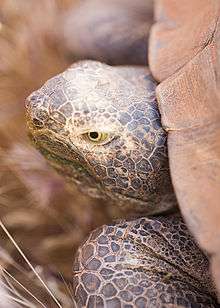Homopus boulengeri
| Homopus boulengeri | |
|---|---|
 | |
| Karoo padloper | |
| Scientific classification | |
| Kingdom: | Animalia |
| Phylum: | Chordata |
| Subphylum: | Vertebrata |
| Class: | Reptilia |
| Order: | Testudines |
| Family: | Testudinidae |
| Genus: | Homopus |
| Species: | H. boulengeri |
| Binomial name | |
| Homopus boulengeri Duerden, 1906 [1] | |
| Synonyms[2] | |
Homopus boulengeri, commonly known as the Karoo padloper or Boulenger's cape tortoise, is a species of tortoise endemic to the Nama Karoo Region of South Africa.[3][4][5][6][7]
Naming
Homopus boulengeri is known by several common names. In southern Africa (and in much of the scientific community) it is known as the Karoo padloper, as it is the padloper species which is endemic to the Nama Karoo.[3][4] It is also sometimes known as Boulenger's cape tortoise, as the Donner-weer tortoise[7][8][9] or as Boulenger's padloper.[10]
The specific name, boulengeri, and some of the common names are in honor of Belgian-born British herpetologist George Albert Boulenger.[11]
Description
The Karoo padloper is a small tortoise with a relatively flat, brown shell (olive to reddish or orange brown). Though almost always of a uniform colour, the vertebral shields of its shell sometimes have slightly darker edges - especially in young specimens. Its colouration makes it especially well camouflaged in its arid rocky Karoo habitat.
Like the closely related speckled padloper (Homopus signatus) and Nama padloper (Homopus solus) to the west, it has five clawed toes on its front feet and four on its hind feet. Their weight is generally 100 to 150 grams (3.5 to 5.3 oz). The average carapace length is 100 mm (3.9 in), though adult females are larger than males. Adult males can also be distinguished from females by having slightly longer tails, and a concave belly (plastron).[12]
It looks superficially similar to the larger greater padloper (Homopus femoralis) of the grasslands in the east. However the Karoo Padloper can be distinguished by its uniform colouration, its having five toes on its front feet versus four toes on its back feet, the smaller scales on its forelimbs, and its nostrils which are level with or above its eyes.
Distribution and habitat
This small, shy tortoise occurs at relatively low densities in the succulent and desert shrubland of the central Karoo.
In its natural environment in the Great Karoo, it usually inhabits rocky outcrops and ridges of shale and ironstone. Here it hides in rock cracks and under ledges (rather than under vegetation, like many other tortoises). It has a very specialised diet (and therefore has a very poor survival rate in captivity). It is known for emerging just before thunderstorms, from which it got its local Afrikaans name of "Donnerweerskilpad" ("thunder tortoise").[13]
Conservation and captivity
It is threatened by habitat destruction,[8] traffic on roads, overgrazing, and poaching for the pet trade.[14] As the trade in collected Homopus species is strictly illegal and any captive specimens are systematically registered in noncommercial studbooks in South Africa and Namibia, any commercial sale of Homopus tortoises is almost without exception strictly illegal.[15]
The species does not survive well in captivity, unless considerable effort is made to supply specimens with their natural food, that is, the indigenous plants from the Nama Karoo Region. It also has very specific temperature, moisture and climate requirements.[16]
References
- ↑ Homopus boulengeri, Duerden, 1906, Taxonomic Serial No.: 551785, Retrieved August 20, 2013, from the Integrated Taxonomic Information System (ITIS) on-line database, http://www.itis.gov.
- ↑ Fritz, Uwe; Havaš, Peter (2007). "Checklist of Chelonians of the World". Vertebrate Zoology. 57 (2): 282. ISSN 1864-5755. Archived from the original (PDF) on 2010-12-17. Retrieved 29 May 2012.
- 1 2 Homopus Research Foundation website
- 1 2 Save Our Tortoises, CapeNature web site.
- ↑ IUCN.org IUCN Appendix 1. Regional Species Lists
- ↑ F. Slavens and K. Slavens, Reptiles and Amphibians in Captivity – Breeding, Longevity and Inventory, 1991.
- 1 2 Homopus boulengeri (Boulenger's Cape Tortoise), Zipcodezoo.com.
- 1 2 Obst, J.; Richter, K.; Jacob, U. 1988. The Completely Illustrated Atlas of Reptiles and Amphibians for the Terrarium. T.F.H. Press.
- ↑ The Herpetology Sourcebook, Reptile & Amphibian Magazine, 1996-1997.
- ↑ Branch 2004.
- ↑ Beolens, B.; Watkins, M.; Grayson, M. 2011. The Eponym Dictionary of Reptiles. Baltimore: Johns Hopkins University Press. xiii + 296 pp. ISBN 978-1-4214-0135-5. (Homopus boulengeri, p. 34).
- ↑ Baard, E.H.W. 1994. Cape Tortoises: Their identification and care. Cape Nature Conservation.
- ↑ Boycott, R.; Bourquin, O. 1998. The South African Tortoise Book. Johannesburg: Southern Book Publishers.
- ↑ http://home.caiway.nl/~loehr/tortoises.html
- ↑ http://www.capenature.org.za/resources.htm?sm[p1][category]=749&sm[p1][persistent]=1
- ↑ Corton, M., Homopus (Padloper Tortoise) Care, World Chelonian Trust (retrieved August 20, 2013).
Further reading
- Branch, Bill. 2004. Field Guide to Snakes and Other Reptiles of Southern Africa. Third Revised edition. Second impression. Sanibel Island, Florida: Ralph Curtis Books. 399 pp. ISBN 0-88359-042-5. (Homopus boulengeri, pp. 27–28 + Plate 6).
- Duerden JE. 1906. South African Tortoises of the Genus Homopus, with Description of a New Species. Records of the Albany [South Africa] Museum 1: 405-411. (Homopus boulengeri, new species, pp. 406–407).
